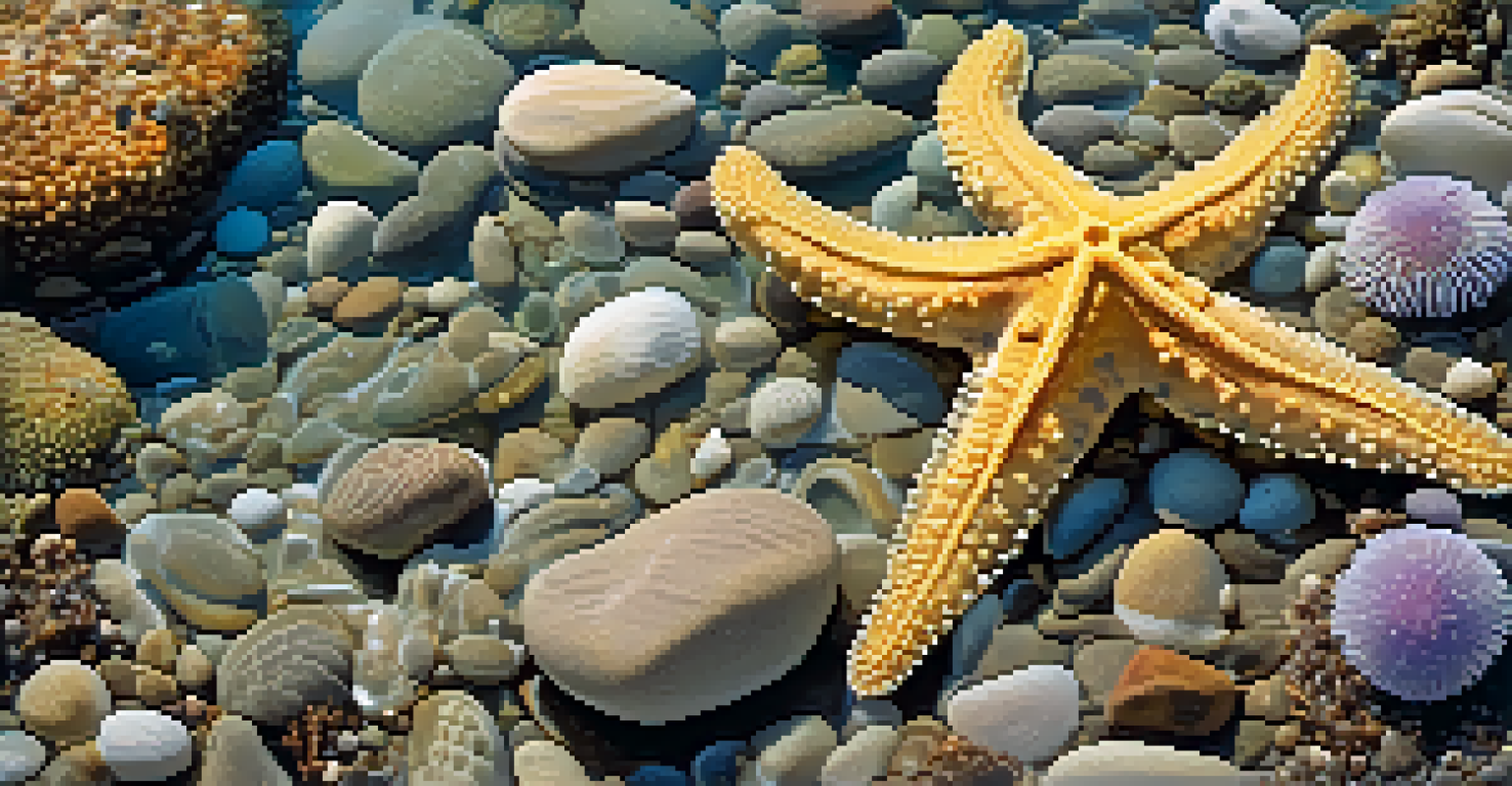The Coastal Ecosystem: Flora and Fauna of California's Shores

Overview of California's Coastal Ecosystem
California's coastline stretches over 800 miles, showcasing a unique and vibrant ecosystem. This region is a meeting point for terrestrial and marine environments, creating a rich habitat for various species. The coastal ecosystem is not only beautiful but also vital for biodiversity, offering homes to countless plants and animals.
In every walk with nature one receives far more than he seeks.
From sandy beaches to rocky cliffs, each area of the coast supports different types of flora and fauna. The diversity of habitats contributes to the overall health of the ecosystem, making it a critical area for conservation efforts. Understanding this ecosystem helps us appreciate the delicate balance of life along California's shores.
Moreover, the coastal ecosystem plays a significant role in climate regulation and provides resources for local communities. It supports fishing industries, tourism, and recreational activities, emphasizing the importance of protecting these natural treasures.
Key Plant Species Along California's Coast
The coastal environment in California is home to a variety of plant species that thrive in sandy and rocky soils. Iconic plants like the coastal sage scrub and sea oats are adapted to withstand harsh conditions, such as salt spray and shifting sands. These plants not only provide beauty but also stabilize the dunes and soil, preventing erosion.

Another fascinating plant is the giant kelp, which forms underwater forests along the coast. This fast-growing seaweed provides essential habitat and food for numerous marine species. Its presence is a testament to the health of the marine ecosystem and highlights the interconnectedness of coastal life.
Biodiversity is Essential
California's coastal ecosystems are rich in biodiversity, providing vital habitats for a wide array of plant and animal species.
Additionally, native wildflowers, such as California poppies, bloom along coastal areas, adding vibrant colors to the landscape. These plants are crucial for pollinators like bees and butterflies, further supporting the ecosystem's diversity. Protecting these native flora is essential for maintaining the overall health of California's coastal regions.
Marine Life: The Wonders Below the Surface
California's coastal waters are teeming with life, from colorful fish to majestic sea mammals. The diversity of marine species is astounding, with over 500 species of fish found in these waters. Popular species like the California halibut and rockfish are not only critical for the ecosystem but also vital for local fisheries.
The earth has music for those who listen.
In addition to fish, the coastline is home to marine mammals such as sea lions, seals, and even migrating gray whales. These creatures can often be spotted basking on rocks or breaching the surface during their migratory journeys. Their presence highlights the rich tapestry of life in California's coastal waters.
Moreover, the health of marine life is closely linked to the overall well-being of the coastal ecosystem. Pollution and overfishing pose significant threats to these species, making conservation efforts crucial for their survival. Protecting marine habitats ensures these magnificent creatures continue to thrive along California's shores.
Bird Species: A Haven for Avian Life
California's coastal ecosystems serve as vital stopover points for migratory birds along the Pacific Flyway. A wide variety of bird species can be spotted here, from shorebirds like sandpipers to seabirds such as pelicans and gulls. These birds rely on the rich food sources and diverse habitats offered by the coastline.
Wetlands, estuaries, and sandy beaches provide essential nesting and feeding grounds for many avian species. The interplay between land and sea creates a dynamic environment that supports both resident and migratory birds. Observing these birds in their natural habitat is a rewarding experience for birdwatchers and nature enthusiasts alike.
Human Impact Threatens Ecosystems
Human activities such as pollution and overfishing pose significant threats to the delicate balance of California's coastal ecosystems.
The conservation of these habitats is crucial, as many bird species are facing threats from habitat loss and climate change. Protecting nesting sites and ensuring clean waterways will help maintain the avian diversity that is so prominent along California's shores.
The Role of Tides in Coastal Ecosystems
Tides play a significant role in shaping California's coastal ecosystems, influencing everything from habitat availability to species interactions. The rhythmic rise and fall of ocean waters create unique environments such as tidal pools, which are teeming with life. These pools provide a fascinating glimpse into the diversity of organisms that can survive in varying conditions.
As the tides change, different species become exposed or submerged, leading to dynamic interactions among marine life. For instance, some animals, like sea stars and anemones, thrive in tidal pools, while others are more adapted to open waters. Understanding these interactions helps us appreciate the complexity of coastal ecosystems.
Moreover, tides also affect nutrient delivery, as they bring in fresh seawater filled with essential minerals and food sources. This nutrient flow supports the entire food web, from microscopic plankton to larger marine species. The health of the ecosystem is intricately linked to these tidal movements, highlighting the importance of maintaining natural tidal patterns.
Human Impact on Coastal Ecosystems
While California's coastal ecosystems are rich in biodiversity, they face numerous challenges from human activities. Pollution, coastal development, and climate change are significant threats that can disrupt the delicate balance of these habitats. For instance, plastic waste can harm marine life and degrade vital nesting areas for birds.
Overfishing is another pressing concern, as it can deplete fish populations and disrupt food chains. Sustainable fishing practices are essential to ensure that marine species can thrive and reproduce. By being mindful of our impact, we can help protect the resources that coastal ecosystems provide.
Conservation is Key for the Future
Active conservation efforts, including marine protected areas, are crucial for preserving California's coastal habitats and their biodiversity for future generations.
Community involvement and awareness are crucial in mitigating these impacts. Local initiatives aimed at beach cleanups, habitat restoration, and environmental education encourage people to take action. Together, we can foster a sense of stewardship for California's coastal ecosystems and work towards a sustainable future.
Conservation Efforts and Future Directions
Conservation efforts are critical for preserving California's coastal ecosystems and ensuring their health for future generations. Various organizations and governmental bodies are actively engaged in protecting habitats, restoring damaged areas, and promoting sustainable practices. These initiatives highlight the importance of collaboration between communities, scientists, and policymakers.
Marine protected areas (MPAs) have been established along California's coast to safeguard vital habitats and promote biodiversity. These designated zones restrict certain activities, allowing ecosystems to recover and thrive. The success of MPAs demonstrates the positive impact of strategic conservation efforts on marine life.

Looking forward, ongoing research and community engagement will play a pivotal role in shaping the future of California's coasts. By continuing to raise awareness and promote conservation, we can ensure that the rich flora and fauna of these ecosystems are preserved for generations to come.